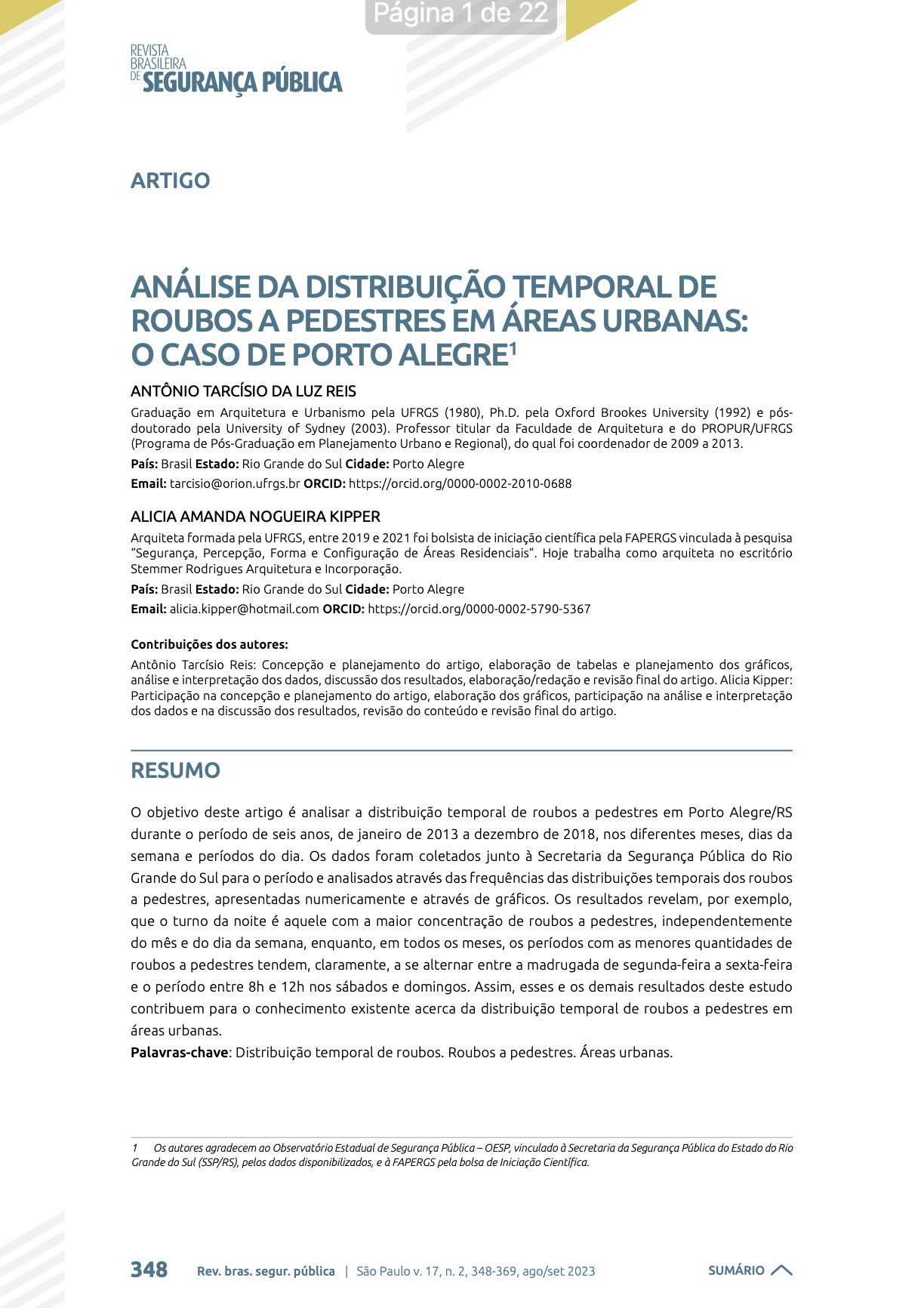Analysis of the temporal distribution of pedestrian robberies in urban areas
the case of Porto Alegre
DOI:
https://doi.org/10.31060/rbsp.2023.v17.n2.1690Keywords:
Urban areas, Pedestrian Robberies, Temporal Distribution of RobberiesAbstract
The aim of this paper is to analyze the temporal distribution of pedestrian robberies in Porto Alegre over a period of six years, in different months, days of the week and periods of the day. Data were collected from the Department of Public Security of Rio Grande do Sul for the period from January 2013 to December 2018. Data were analyzed through the frequencies of temporal distributions of robberies and presented numerically and through graphics. The results reveal, for example, that the night period is that with the highest concentration of pedestrian robberies, regardless of the month and day of the week, while, in all months, the periods with the lowest amounts of pedestrian robberies tend, clearly, to alternate between dawn from Monday to Friday and the period between 8am and until 12pm on Saturdays and Sundays. Thus, these and other results of this study contribute to the existing knowledge about the temporal distribution of pedestrian robberies in urban areas.Downloads
References
ANDRESEN, M. A.; MALLESON, N. Crime seasonality and its variations across space. Applied Geography, v. 43, p. 25-35, 2013.
CARBONE-LOPEZ, K.; LAURITSEN, J. Seasonal variation in violent victimization: opportunity and the annual rhythm of the school calendar. Journal of Quantitative Criminology, v. 29, n. 3, p. 399-422, 2013. DOI:10.1007/s10940-012-9184-8.
CECCATO, V. Homicide in San Paulo, Brazil: assessing spatial-temporal and weather variations. Journal of Environmental Psychology, v. 25, n. 3, p. 307-321, 2005. DOI: https://doi.org/10.1016/j.jenvp.2005.07.002.
COHEN, L. E.; FELSON, M. Social change and crime rate trends: a routine activity approach. American Sociological Review, v. 44, n. 4, p. 588-608, 1979. DOI: https://doi.org/10.2307/2094589.
COHN, E. G.; ROTTON, J. Assault as a function of time and temperature: a Moderator-variable time-series analysis. Journal of Personality and Social Psychology, v. 72, n. 6, p. 1322-1334, 1997. DOI: https://doi.org/10.1037/0022-3514.72.6.1322.
FIGUEIREDO, C. A. Interfaces térreas entre edificações e espaços abertos públicos: efeitos para estética, uso e percepção de segurança urbana. Dissertação (Mestrado em Planejamento Urbano) – Faculdade de Arquitetura, Universidade Federal do Rio Grande do Sul, Porto Alegre/RS, 2018. 275p.
HILLIER, B. Space is the Machine: A Configurational Theory of Architecture. London: Space Syntax, 1996.
HILLIER, B.; SAHBAZ, O. High resolution analysis of crime patterns in urban street networks: an initial statistical sketch from an ongoing study of a London Borough. In: Proceedings of the V International Space Syntax Symposium. Delft: University of Technology, 2005, p. 451-478.
JACOBS, J. The Death and Life of Great American Cities. London: Penguin, 1961.
MELO, S. N.; PEREIRA, D. V. S.; ANDRESEN, M. A.; MATIAS, L. F. Spatial/Temporal variations of crime: a routine activity theory perspective. International Journal of Offender Therapy and Comparative Criminology, v. 62, n. 7, p. 1967-1991, 2018. DOI: https://doi.org/10.1177/0306624X17703654.
MONTEIRO, L. T. The Valley of Fear – The morphology of crime, a case study in João Pessoa, Paraíba, Brasil. In: Proceedings of the VIII International Space Syntax Symposium. Santiago de Chile: PUC, 2012, p. 1-15.
MONTEIRO, C.; CAVALCANTI, R. Perfis espaciais urbanos para avaliação de lugares vulneráveis ao crime. In: NETTO, V.; SABOYA, R. T.; VARGAS, J. C.; CARVALHO, T. Efeitos da Arquitetura: os impactos da urbanização contemporânea no Brasil. 2 ed. Brasília: FRBH, 2019, p. 137-161.
MONTEIRO, C.; IANNICELLI, C. Spatial Profiles of Urban Crimes: the role of morphology in a context of social inequality. In: Proceedings of the VII International Space Syntax Symposium. Stockholm: Royal Institute of Technology, 2009, p. 1-11.
PEREIRA, D. V. S.; ANDRESEN, M. A.; MOTA, C. M. M. A temporal and spatial analysis of homicides. Journal of Environmental Psychology, v. 46, p. 116-124, 2016. DOI: https://doi.org/10.1016/j.jenvp.2016.04.006.
QUINTANA, E. B. Influência de características físico-espaciais na ocorrência de crimes e na percepção de segurança em áreas residenciais com condomínios fechados. Dissertação (Mestrado em Planejamento Urbano) – Faculdade de Arquitetura, Universidade Federal do Rio Grande do Sul, Porto Alegre/RS, 2013.
REIS, A. T. L.; ANDORFFY, T.; MARCON, L. Relationship Between Some Physical Spatial Variables and Four Types of Street Crimes. In: Proceedings of the X International Space Syntax Symposium. London: Space Syntax Laboratory, The Bartlett School of Architecture, 2015, p. 1-9.
REIS, A. T. L.; ELY JUNIOR, C. F.; EISENHUT, C. S. Atributos físico-espaciais e configuracionais de segmentos de ruas e ocorrências de roubos a pedestres. Ambiente Construído, v. 19, n. 4, p. 55-77, 2019.
REIS, A. T. L.; BERTONI, A. S.; MARQUES, C. A. N.; MANO, C. M. Cercar ou não o Parque Farroupilha? Uma análise envolvendo uso e segurança. ARQUISUR Revista, v. 6, n. 10, p. 54-71, 2016.
SAHBAZ, O.; HILLIER, B. The story of the crime: functional, temporal and spatial tendencies in street robbery. In: Proceedings of the VI International Space Syntax Symposium. Istanbul: Istanbul Technical University, 2007, p. 1-14.
TOMPSON, L.; BOWERS, K. A stab in the dark? A research note on temporal patterns of street robbery. Journal of Research in Crime & Delinquency, v. 50, n. 4, p. 616-631, 2013. DOI: https://doi.org/10.1177/0022427812469114.
TRUJILLO, J. C.; HOWLEY, P. The effect of weather on crime in a torrid urban zone. Environment and Behavior, v. 53, n. 1, p. 69-90, 2021.
VIVAN, M.; SABOYA, R. Arquitetura, espaço urbano e criminalidade: efeitos de visibilidade na distribuição de ocorrência de crimes. In: NETTO, V.; SABOYA, R. T.; VARGAS, J. C.; CARVALHO, T. Efeitos da Arquitetura: os impactos da urbanização contemporânea no Brasil. 2 ed. Brasília: FRBH, 2019, p. 163-182.

Downloads
Published
How to Cite
Issue
Section
License
Copyright (c) 2023 Revista Brasileira de Segurança Pública

This work is licensed under a Creative Commons Attribution 4.0 International License.
Licensing
The Brazilian Journal of Public Security uses the Creative Commons License as a form of licensing for its published works. The license used follows the CC BY 4.0 - Attribution 4.0 International model.
To see the permitted rights please go to the full licence or to our Copyright and Licensing page.


